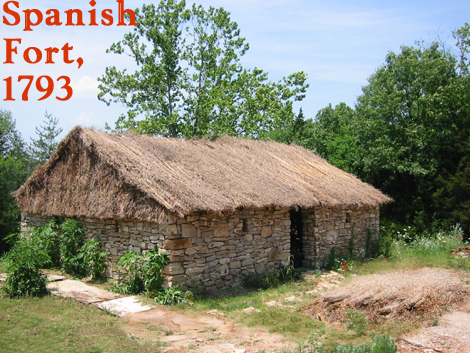

Boonesfield Village has acquired another treature: a newly discovered small Spanish Fort built in 1793. It is now located across the highway from the Boone Home. The following article is courtesy of the St. Louis Post Dispatch and St. Louis Today.
Fort built in 1793 will now guard
area's past
By Valerie Schremp Hahn
ST. LOUIS POST-DISPATCH
Sunday, Mar. 12 2006
ST. CHARLES COUNTY
An 18th-century stone fort discovered in St. Charles and rebuilt
in Defiance
could be one of the biggest historical finds in Missouri in the
last 50 years,
experts say, but until recently, almost no one knew it existed.
"Does it make a lot of noise, and is it flashy?"
asks C.W. Stewart, director of
the Daniel Boone Home and Boonesfield Village in
Defiance. "No, but it's a real
find. How many 1793 buildings are we going to find that weren't
known?"
For more than 200 years, the fort sat on property off
what is now Muegge Road,
where Fischer & Frichtel is building Spring Mill, a development
of luxury homes
that start at about $500,000.
In 2004, as developers cleared farmland on the site, they discovered
that the
barn had a unique interior. The barn was wood on the outside,
but on the
inside, four thick stone walls held up its second floor. The stone
walls formed
a room on the barn's first floor, which was probably once used
as a livestock
crib.
Word about the building spread to officials at Lindenwood
University ,which runs Boonesfield, and the developer
asked if they
wanted it. At first, Stewart shrugged off the offer - "I
need another building
like I need another hole in my head," he said - but he figured
he'd use the
stone for sidewalks or fireplaces.
The developer then told Stewart: "It's got the neatest
little gunports in the
walls."
Stewart knew that anything with gunports had to be built before
1815, when the
government and Indian tribes signed a peace treaty.
"I'll be right over," he said.
Stewart, historian Ken Kamper and archaeologist Steve Dasovich
didn't even know
what they had until they did a little digging - literally. They
found records
from September 1792, when Lt. Gov. Zenon Trudeau wrote a letter
to his boss,
Baron de Carondelet, the governor of what at the time was known
as Spanish
Louisiana and included what is now Missouri. Trudeau reported
that Iowa Indians
had stolen 38 horses from the village of San Carlos, now known
as St. Charles.
The horses were the only ones the villagers had to work the land,
and there was a bad wheat harvest that year as well.
Subsequent letters showed that life got better in San Carlos.
In July 1793, the
Indians gave the villagers 37 horses and paid for the other
one.
Because all the horses were stolen at once, they were probably
being kept in a
common pasture for the village - probably what was known as the
old common
fields, the researchers figure. They studied old maps and, sure
enough, the
fort stood in the center of the common fields. Stewart said the
villagers most
likely built it to protect their horses from being stolen again.
Because the
horses were returned relatively quickly, the villagers probably
never had to
use it.
"The reason that we found it and the reason why it exists
is because it was
unimportant," Stewart said. "It was never used. The
only useful thing it did
was hold up a barn."
Kamper notes that the Spanish forts that once protected St.
Charles and St.
Louis are gone, as well as any evidence of the first settlers
in the 1700s.
"Ste. Genevieve still has a lot of the early, pre-American
buildings there, but
this probably is the only record of a Spanish fort that still
exists west of
the Mississippi River, so that makes it a major thing," he
said.
Dasovich conducted an archeological study of the grounds around
the fort and
didn't find anything significant, which would back up the theory
that the fort
was never used for its intended function.
The researchers did learn through tree ring dating that the
barn dates to 1852,
probably built on the stone walls by the Blase family, who later
farmed the
land. The farm was turned over to the Holtgraewe family, and the
land was
eventually sold to the developer. Family names belonging to the
Holtgraewes
make up Spring Mill's street names - Otto Court, Robert John's
Way, Dorothy Ann
Court.
In August 2004, after Lindenwood workers took several pictures
of the fort and
made mechanical drawings, they splashed eight different colors
of paint on each
interior and exterior wall. They knocked down the walls and hauled
truckloads
of stone to Boonesfield Village .
The stone sat in piles until last summer, when stonemasons
used the drawings,
pictures and paint colors to rebuild the walls. Lindenwood paid
about $30,000 to move and rebuild the fort.
The building is about 24 by 32 feet and its walls are about
18 inches thick. It
has a main entrance, and each wall has two gunports - openings
wider on the
inside and narrower on the outside. Although each stone isn't
back in the exact
spot it was originally, the stones fit together surprisingly well,
and the
building looks solid and, well, fortress-like.
The fort's roof is now being thatched with river cane, a type
of bamboo, and
the fort should be open to the public early next month .
Eventually, workers will scrub away whatever paint is left
showing on the
rocks. Because the fort sits on a hillside, benches may be installed
for people
to watch presentations about the fort and the area's early Spanish
history.
Everyone involved with preserving the fort agrees: The county's
lucky to have
it, even though it took more than 200 years to find.
"It would have been a shame for this to have wound up
in a sidewalk," Stewart
said.
vschremp@post-dispatch.com
636-255-7211